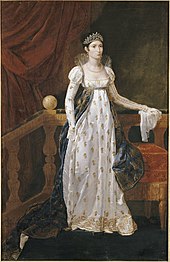Elisa Bonaparte

Élisa Bonaparte (born Maria Anna Elisa Buonaparte , born January 3, 1777 in Ajaccio , Corsica , † August 7, 1820 in Villa Vicentina ) was Napoleon Bonaparte's eldest sister , who reached adulthood. During the Napoleonic era she was Princess of Lucca and Piombino and Grand Duchess of Tuscany .
Early years
Elisa enjoyed a good upbringing at the Maison Royale de Saint-Louis in Saint-Cyr-l'École . Although there were numerous applicants for her hand, on May 1, 1797, she married Félix Baciocchi , an impoverished Corsican nobleman. This was an officer in Napoleon's service. Elisha's dowry consisted of 35,000 francs and modest possessions in Corsica .
Contrary to Napoleon's attempt to deport the couple to the Mediterranean island, Elisa managed to transfer her husband to Paris . She tried to establish herself there as a salonnière . Only after her brother's political ascent did she host important personalities, particularly from literature and art, such as Jacques-Louis David .
Princess in Italy

After the establishment of the Empire, various female members of the Bonaparte family received the rank of princesses. Elisa and Caroline Bonaparte were not among them and then made a scene for their brother. This gave in to the extent that he declared the sisters to be Imperial Highnesses. Caroline's husband, Joachim Murat , was appointed Grand Duke von Berg and Félix Baciocchi was appointed Senator . Like her husband, Elisa received 240,000 francs. These were not enough for her and at her insistence, Napoleon made her princess of Piombino . After various intrigues, she succeeded in getting her husband appointed Prince of Lucca .
She herself, however, was the actual ruler. She had a new palace, a theater, a bath and a casino built in Lucca . The latter generated high revenues before Napoleon ordered its closure. Elisa Bonaparte took a number of measures to increase the economic strength of her territory. This included building roads, draining swamps and fighting the brigands . She introduced the breeding of silkworms and reformed the judiciary and the police. In addition, she increased her own income through various measures such as buying an alum pit or monopolizing the tuna fishery. She had ironworks built and ore mines exploited. She used the marble quarries in Carrara profitably by having busts of Napoleon made. The portraits were widespread in the offices of the empire. She also founded a sculpture school in Carrara. She promoted Niccolò Paganini by employing him in the chapel of her court and making him honorary captain.
As a result of the status survey, the couple separated. Elisa resided in the Palazzo Pitti while her husband lived in the Palazzo della Crocetta. Both had different extramarital affairs.
She did everything to become ruler of Tuscany . In 1809, however, she only partially succeeded: Napoleon appointed her governor of Tuscany with the personal title of Grand Duchess. Her husband became a general of the troops.
When the end of Napoleonic rule was looming, Elisha tried in vain to keep her throne. After she was expelled from Florence and fled to Lucca, she severed all ties to the Empire. However, this did not save them from the British occupation of Lucca and their deposition.
After the deposition

Temporarily interned, Elisa Bonaparte was released after the end of the reign of the hundred days . She lived with her husband in Trieste, watched over by the Austrians. She took on the title of Contessa di Compignano. She bought a town house and the Villa Vicentina in the country. The Austrian government returned her private Italian possessions in 1819. She sold these and was able to live comfortably on the proceeds. She later acquired new property in Italy. She died unexpectedly of malaria in 1820 . She left most of her property to her children.
She and her husband had four children, two of whom reached adulthood. Among them was the daughter Elisa Napoléone, who later married Count Camerata-Passionei di Mazzoleni.
progeny
- Felix Napoléon Baciocchi (1798–1799)
- Elisa Napoléone Baciocchi (1806–1869)
- Jérôme Charles Baciocchi (1810-1811)
- Frédéric Napoléon Baciocchi (1814–1833)
literature
- David Stacton: The Bonapartes . Zsolnay, Vienna and Hamburg 1968, pp. 78-85, pp. 194f.
Trivia
The composer Franz Lehár set a musical monument for her in his operetta Paganini . There, as the mistress of the title hero, she is the main female actor.
Web links
- Literature by and about Elisa Bonaparte in the SUDOC catalog (Association of French University Libraries)
| personal data | |
|---|---|
| SURNAME | Bonaparte, Elisa |
| ALTERNATIVE NAMES | Buonaparte, Maria Anna Elisa (maiden name) |
| BRIEF DESCRIPTION | Sister of Napoleon Bonaparte |
| DATE OF BIRTH | January 3, 1777 |
| PLACE OF BIRTH | Ajaccio , Corsica |
| DATE OF DEATH | August 7, 1820 |
| Place of death | St. Andrea , Trieste |
